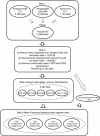Meta-prediction of phosphorylation sites with weighted voting and restricted grid search parameter selection
- PMID: 18234718
- PMCID: PMC2275094
- DOI: 10.1093/nar/gkm848
Meta-prediction of phosphorylation sites with weighted voting and restricted grid search parameter selection
Abstract
Meta-predictors make predictions by organizing and processing the predictions produced by several other predictors in a defined problem domain. A proficient meta-predictor not only offers better predicting performance than the individual predictors from which it is constructed, but it also relieves experimentally researchers from making difficult judgments when faced with conflicting results made by multiple prediction programs. As increasing numbers of predicting programs are being developed in a large number of fields of life sciences, there is an urgent need for effective meta-prediction strategies to be investigated. We compiled four unbiased phosphorylation site datasets, each for one of the four major serine/threonine (S/T) protein kinase families-CDK, CK2, PKA and PKC. Using these datasets, we examined several meta-predicting strategies with 15 phosphorylation site predictors from six predicting programs: GPS, KinasePhos, NetPhosK, PPSP, PredPhospho and Scansite. Meta-predictors constructed with a generalized weighted voting meta-predicting strategy with parameters determined by restricted grid search possess the best performance, exceeding that of all individual predictors in predicting phosphorylation sites of all four kinase families. Our results demonstrate a useful decision-making tool for analysing the predictions of the various S/T phosphorylation site predictors. An implementation of these meta-predictors is available on the web at: http://MetaPred.umn.edu/MetaPredPS/.
Figures
Similar articles
-
PhosphoRice: a meta-predictor of rice-specific phosphorylation sites.Plant Methods. 2012 Feb 3;8:5. doi: 10.1186/1746-4811-8-5. Plant Methods. 2012. PMID: 22305189 Free PMC article.
-
GPS: a novel group-based phosphorylation predicting and scoring method.Biochem Biophys Res Commun. 2004 Dec 24;325(4):1443-8. doi: 10.1016/j.bbrc.2004.11.001. Biochem Biophys Res Commun. 2004. PMID: 15555589
-
Evaluation of protein phosphorylation site predictors.Protein Pept Lett. 2010 Jan;17(1):64-9. doi: 10.2174/092986610789909412. Protein Pept Lett. 2010. PMID: 19508198
-
Meta-prediction of protein subcellular localization with reduced voting.Nucleic Acids Res. 2007;35(15):e96. doi: 10.1093/nar/gkm562. Epub 2007 Aug 1. Nucleic Acids Res. 2007. PMID: 17670799 Free PMC article.
-
PPSP: prediction of PK-specific phosphorylation site with Bayesian decision theory.BMC Bioinformatics. 2006 Mar 20;7:163. doi: 10.1186/1471-2105-7-163. BMC Bioinformatics. 2006. PMID: 16549034 Free PMC article.
Cited by
-
Prepatterning in the stem cell compartment.PLoS One. 2010 May 28;5(5):e10901. doi: 10.1371/journal.pone.0010901. PLoS One. 2010. PMID: 20531938 Free PMC article.
-
A strategy for interaction site prediction between phospho-binding modules and their partners identified from proteomic data.Mol Cell Proteomics. 2010 Dec;9(12):2745-59. doi: 10.1074/mcp.M110.003319. Epub 2010 Aug 23. Mol Cell Proteomics. 2010. PMID: 20733106 Free PMC article.
-
Incorporating post-translational modifications and unnatural amino acids into high-throughput modeling of protein structures.Bioinformatics. 2014 Jun 15;30(12):1681-9. doi: 10.1093/bioinformatics/btu106. Epub 2014 Feb 25. Bioinformatics. 2014. PMID: 24574112 Free PMC article.
-
An ensemble method approach to investigate kinase-specific phosphorylation sites.Int J Nanomedicine. 2014 May 10;9:2225-39. doi: 10.2147/IJN.S57526. eCollection 2014. Int J Nanomedicine. 2014. PMID: 24872686 Free PMC article.
-
Integrated Strategy Improves the Prediction Accuracy of miRNA in Large Dataset.PLoS One. 2016 Dec 21;11(12):e0168392. doi: 10.1371/journal.pone.0168392. eCollection 2016. PLoS One. 2016. PMID: 28002428 Free PMC article.
References
-
- Tompa M, Li N, Bailey TL, Church GM, De Moor B, Eskin E, Favorov AV, Frith MC, Fu Y, et al. Assessing computational tools for the discovery of transcription factor binding sites. Nat. Biotechnol. 2005;23:137–144. - PubMed
-
- Cuthbertson JM, Doyle DA, Sansom MS. Transmembrane helix prediction: a comparative evaluation and analysis. Protein Eng. Des. Sel. 2005;18:295–308. - PubMed
-
- Kapp EA, Schutz F, Connolly LM, Chakel JA, Meza JE, Miller CA, Fenyo D, Eng JK, Adkins JN, et al. An evaluation, comparison, and accurate benchmarking of several publicly available MS/MS search algorithms: sensitivity and specificity analysis. Proteomics. 2005;5:3475–3490. - PubMed
Publication types
MeSH terms
Substances
Grants and funding
LinkOut - more resources
Full Text Sources
Other Literature Sources
Research Materials


